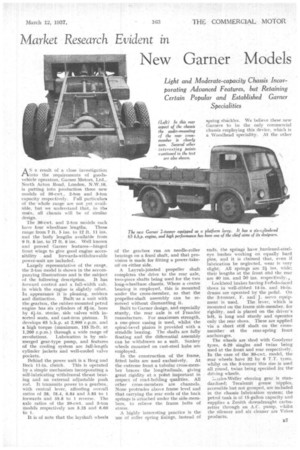Market Research Evident in
Page 41

If you've noticed an error in this article please click here to report it so we can fix it.
New Garner Models
AS a result of a close investigation AS
the requirements of goodsvehicle operators, Garner Motors, Ltd., North Acton Road, London, N.W.10, is putting into production three new models of 30-cwt., 2-ton and 3-ton capacity respectively. Full particulars of the whole range are not yet available, but we understand that, in the main, all chassis will be of similar design.
The 30:cwt. and 2-ton models each have four wheelbase lengths. These range from 7 ft. 5 ins. to 12 ft. 11 ins. and the body lengths available from 9 ft. 8 ins. to 17 ft. 6 ins. Well known and proved Garner features—hinged front wings to give good engine accessibility . and forwards-withdrawable power-unit are included.
Largely representative of the range, the 2-ton model is shown in the accompanying illustrations and is the subject of the following description. It has forward control and a full-ividth cab, in which the engine is slightly offset. In appearance it is pleasing, rn&lern and distinctive. Built as a unit with the gearbox, the rubber-mounted petrol engine has six cylinders of 31-in. bore by 4I-in. stroke, side valves with inserted seats, and cast-iron pistons. It develops 65 b.h.p. at 2,900 r.p.m. and a high torque (maximum, 155 lb-ft. at 1,200 r.p.m.) through a wide range of
revolutions. Lubrication is by submerged gear-type pump, and features of the cooling system are full-length cylinder jackets and well-cooled valve pockets.
Behind the power unit is a Borg and Beck 11-in. clutch. This is operated by a simple mechanism incorporating a self-lubricating withdrawal thrust bearing and an external adjustable push rod. It transmits power to a gearbox, with central lever, affording overall ratios of 38, 18.4, 6.84 and 5.85 to 1 forwards and 59.8 to 1 reverse. The axle ratios of the 30-cwt. and 3-ton models respectively are 5.25 and 6.66 to 1.
It is of note that the layshaft wheels of the gearbox run on needle-roller bearings on a fixed shaft, and that provision is made for fitting a power-takeoff on either side.
A Layrub-jointed propeller shaft completes the drive to the rear axle, two-piece shafts being used for the two long-wheelbase chassis. Where a centre bearing is employed, this is mounted under the cross-member, so that the propeller-shaft assembly can be removed without dismantling it.
Built to'Garner design, and especially sturdy, the rear axle is of Frandor manufacture. For maximum strength, a one-piece casing is used, whilst the spiral-bevel pinion is provided with a straddle bearing. The shafts are fully floating and the differential assembly can be withdrawn as a unit. Sankey wheels mounted on cast-steel hubs are employed.
In the construction of the frame, fitted bolts are used exclusively. At the extreme front a tubular cross-member braces the longitudinals, giving great rigidity at a point important in respect of road-holding qualities. All other cross-members are channels. None protrudes above frame level and that carrying the rear ends of the back springs is attached under the side-members, to relieve the frame bolts of stress.
A highly interesting practice is the use of roller spring fixings, instead of
ends, the springs have _hardened-steeleye bushes working on equally hard pins, and it is claimed that, even if lubrication be neglected, wear is very slight. All springs are 21ins, wide; their lengths at the front and the rear are 40 ins. and 50 ins. respectively..
Lockheed brakes having Fertdo-faced shoes in well-ribbed 14-in. and 16-in. drums are operated by the pedal. On the 3-tonner, F. and J. servo equip ment is used. The lever, which is mounted on the frame side-member, for rigidity, and is placed on the driver's left, is long and sturdy and operates only the rear shoes. These are applied via a short stiff shaft on the crossmember at the rear-spring front anchorages.
The wheels are shod with Goodyear tyres, 6-20 singles and twins being used at the front and rear respectively. In the case of the 30-cwt. model, the rear wheels have 32 by 6 T.T. tyres, whilst on the 3-tonner this size is used all round, twins being specified for the driving wheels.
2..isles-Weller steering gear is standardized; Tecalemit grease nipples, accessible but not grouped, are included in the chassis lubrication system; the petrol tank is of 15-gallon capacity and supplies a Zenith downdraught carburetter through an A.C. pump, ishilst the silencer and air cleaner -are Vokes products.




















































































